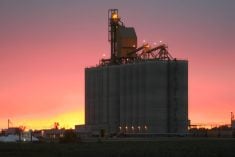In my May 8 blog at www.grainews.ca,
I wrote about a farmer with two older grain trucks — a five-ton tandem and a three ton. The trucks haul grain from the combine to the yard, but this farmer often uses custom truckers— with super Bs — to haul grain to the elevator. The farmer wonders if this is the best solution. He’s looking at three other options:
1. Keep the old gas tandem for field-to-yard use only and buy a used 500-bushel gravity wagon ($10,000) for the same purpose, then custom haul everything out of the yard.
Read Also

Cancer agency reclassifies another herbicide ‘probably carcinogenic’
The WHO’s cancer research agency has now put atrazine, a herbicide well known to corn growers, in the same potential-hazard category where the agency put glyphosate.
2. Buy a newer diesel tandem ($50,000) for occasional trips to the elevator and custom haul when you’ve got large volumes to move at once. The second five-ton would replace the aging and under-sized three ton.
3. Buy a used semi ($60,000 plus more maintenance and upkeep) and haul everything himself.
“The benefit of custom is that 40 tonnes go out of your yard in about an hour and you’re done. You are free to do other things and the GST is refundable,” the farmer says. “Drawbacks can be less flexibility. Custom haulers want to come when you aren’t ready the yard is too wet, etc., and it’s expensive.”
To buy the tandem or semi (over five years) will cost annually about as much as he pays for custom hauling and he will own it after five years. But that purchase cost doesn’t include fuel and time to run his own truck.
“My conclusion so far is stick with custom until I can save more by going the other route, and just have a satisfactory equipment to get from field to yard,” he says.
I then asked readers for their input on this decision. I got some good feedback.
BOUGHT A NEW TA NDEM
Lynn Bryngelson from Elrose, Sask., writes: “I had the same issues to deal with. I had only one grain truck for years. It had to serve both purposes of providing grain and fertilizer for seeding with a fertilizer box within the grain box. During harvest, it created limitations many times, as you a can well imagine. Of course, all of my grain sales were hauled by custom super Bs.
“I really required another truck, but what would it be, another single axle or a tandem? Since I often haul the occasional load 40 km or so to the nearest high-throughput elevator, it would naturally make more sense to up my capacity in that regard. So a tandem was the answer.
“I did not want to adopt the extra maintenance and licensing issues which would be incurred if I went the semi route. I knew that if I purchased a converted highway tractor, it would show anywhere from 200,000 to 1,000,000 km, so I bought a 2003 unit in Arizona with only 36,000 miles. I drove it to Saskatchewan, put a new grain box on, and after operating it for five days, I am very happy and convinced that I made the correct decision.
DO YOU LIKE TRUCKING?
Mark Sloane, Grainews columnist and farmer, says he dealt with this question a great deal with FCC. He writes:
“I firmly believe that the right decision for every farm lies in the following two questions. 1) What does the farm need for trucks to seed the crop, tender water during spraying, and get the crop hauled off the field? 2) What does the farm manager want for an offseason job?
“I saw the financial statements for lots of grain-hauling companies and often the returns were not very impressive. The owners were often simply financing themselves and their drivers’ jobs. If the farm manager would like to truck during the winter months or he has hired men and feels they can afford the time, then purchase that highway tractor, super B trailers and hit the open road.
“If on the other hand the farm manager has other plans for offseason work (farm management, marketing, off-farm employment), then the most efficient truck investment lies in the answer to the first question and then hire the grain to be hauled off the farm.
“Think of it like this: When you are paying someone to haul the















